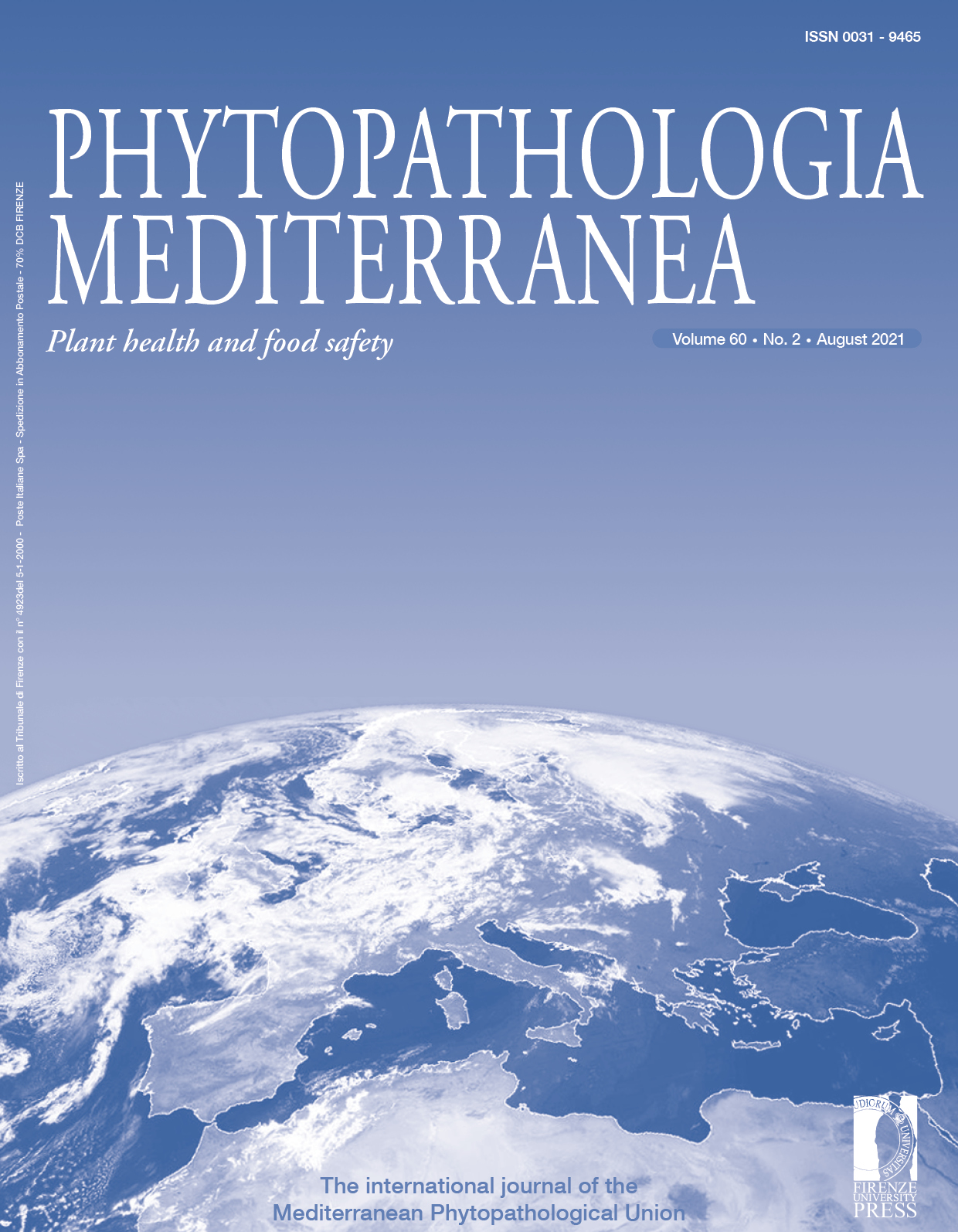First report of Didymosphaeria rubi-ulmifolii associated with canker and dieback of apple trees in southern Ethiopia
Published 2021-09-13
Keywords
- Malus pumila,
- Paraconiothyrium brasiliense,
- stem canker
How to Cite
Abstract
Cultivation of apple trees in the highlands of Ethiopia began in 1955. In 2014, blistering of the bark due to cankers on the main stems mostly below the grafting points, followed by dieback and eventually death of apple trees, was observed in apple orchards in the Hadiya Zone in Ethiopia. This study aimed to identify the causal agent of canker and dieback symptoms on the apple trees. Symptomatic trunks from 20 trees (ten per cultivar) were sampled. Isolations were performed from ten trunks (five per cultivar). Fungus colonies with similar cultural features were obtained from all the samples, and the morphology of a representative isolate was characterized. Phylogenetic analyses of the concatenated internal transcribed spacers 1 and 2 and 5.8S rRNA gene, large subunit and actin gene regions confirmed the identity of two isolates as Didymosphaeria rubi-ulmifolii. Pathogenicity was confirmed for one isolate by inoculations of healthy branches of ‘Anna’ and ‘Dorsett Golden’ apple trees resulting in lesion formation, and subsequent re-isolation of the inoculated fungus. This study is the first report of D. rubi-ulmifolii associated with dieback of apple trees. This pathogen caused death of more than 26% of apple trees in one commercial orchard, and could cause severe losses for smallholder apple growers in Ethiopia. Future studies are required to assess the magnitude, distribution and management options of this economically important canker disease in Ethiopia.
Downloads
References
Ariyawansa H.A., Tanaka K., Thambugala K.M., Phookamsak R., Tian Q., Hyde K.D., 2014b. A molecular phylogenetic reappraisal of the Didymosphaeriaceae(=Montagnulaceae). Fungal Diversity 68, 69104. DOI: 10.1007/s13225-014-0305-6
Bekele-Tesemma A., 2007.Useful trees and Shrubs for Ethiopia: Identification, Propagation and Management for 17 Agroclimatic zones.World Agroforestry Centre, East Africa Region, Nairobi, Kenya, 552 pp.
Cloete M., Fourie P.H., Damm U., Crous P.W., Mostert L., 2011. Fungi associated with dieback symptoms of apple and pear trees, a possible inoculum source of grapevine trunk disease pathogens. Phytopathologia Mediterranea 50, S176S190. DOI: 10.14601/Phytopathol_Mediterr-9004
Erez A., 2000. Bud dormancy; phenomenon, problems and solutions in the tropics and subtropics. In Temperate Fruit Crops in Warm Climates (A. Erez, ed.), Kluwer Academic Publishers, The Netherlands, 17-48.
FAO, 2010. FAOSTAT: statistics database. Food and Agriculture Organization of the United Nations (FAO). Available at: http://www.apps.fao.org/.
Fetena S. and Lemma B., 2014. Assessment on major apple diseases and insect pests in Chencha and Bonke Woredas of Gamo Gofa Zone, Southern Ethiopia. Scholarly Journal of Agricultural Science 4, 394-402.
Fetena S., Shara S., Anjulo A., Gulie G., Woldesenbet F.,Yilma B., 2014. Survey on apple production and variety identification in Chencha District of Gamo Gofa Zone, Southern Ethiopia. Journal of Agricultural Food Technology4, 7-15.
Guindon S, Dufayard J.F., Lefort V., Anisimova M., Hordijk W., Gascuel O., 2010. New algorithms and methods to estimate maximum-likelihood phylogenies: Assessing the performance of PhyML 3.0. Systematic Biology 59, 307–321. DOI: 10.1093/sysbio/syq010
Havenga M., Gatsi G.G., Halleen F., Spies C.F.J., van der Merwe R., Mostert L., 2019. Canker and wood rot pathogens present in young apple trees and propagation material in the Western Cape of South Africa. Plant Disease 103, 3129-3141. DOI: 10.1094/PDIS-04-19-0867-RE
Hailemichael B.G., 2006. Impact of male out-migration on rural women’s livelihood: the case of Chencha woreda, South Ethiopia. MSc Thesis, Addis Ababa University, Addis Ababa, Ethiopia, 120 pp.
Hedberg O.,1989. Pittosporaceae to Araliaceae. In: Flora of Ethiopia and Eritrea. (I. Hedberg, S.Edwards, ed.), The National Herbarium, Addis Ababa, Ethiopia, and Department of Systematic Botany, Uppsala, Sweden, 732.
Katoh K., Standley D.M., 2013. MAFFT multiple sequence alignment software version 7: Improvements in performance and usability. Molecular Biology and Evolution 30, 772-780. DOI: 10.1093/molbev/mst010
Luque, J., Sierra D., Torres E., Garcia F., 2006. Cryptovalsa ampelina on grapevines in N.E. Spain: identification and pathogenicity. Phytopathologia Mediterranea 45, S101-S109. DOI: 10.14601/Phytopathol_Mediterr-1838
Paul, N.C. and Lee H.B., 2014. First Record of Endophytic Paraconiothyrium brasiliense isolated from Chinese Maple Leaves in Korea. Korean Journal of Mycology 42, 349-352. DOI: 10.4489/KJM.2014,42.4.349
Sami, S., Mohammadi H., Heydarnejad J., 2014. Phaeoacremonium species associated with necrotic wood of pome fruit trees in Iran. Journal of Plant Pathology 96 (3), 487-495. DOI: 10.4454/JPP.V9613.006
Sisay A., 2007. Ethiopia-GTZ Promotes apples in the highlands of Ethiopia. Available at: www.nazret.com/news (Accessed November 10, 2017).
Tromp J., 2005. Fruit ripening and quality. In: Fundamentals of Temperate Zone Tree Fruit Production (J. Tromp, A.D. Webster, S. J. Wertheimeds, ed.), Backhuys Publishers, Leiden, The Netherlands, 295-310.
Verkley G.J.M., da Silva M., Wicklow D.T., Crous P.W., 2004. Paraconiothyrium, a new genus to accommodate the mycoparasite Coniothyrium minitans, anamorphs of Paraphaeosphaeria, and four new species. Studies in Mycology 50: 323-335.







